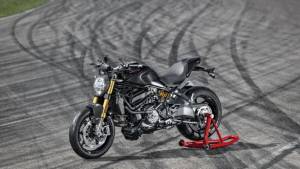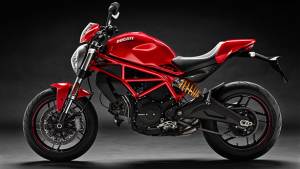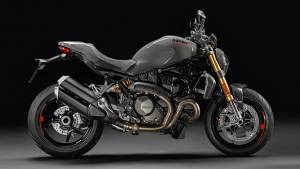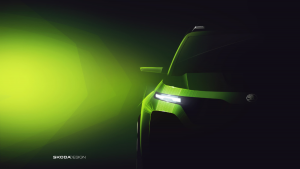2014 Ducati Monster 1200S first ride
Ever heard of Tenerife? Well I didn't until Shumi said I would be going to the island for my next assignment. A quick Google search told me the island is the largest and most populous of the seven Canary Islands situated off the Moroccan coast in the Atlantic Ocean. It's a volcanic island sculpted by frequent eruptions throughout its history. In fact, Mount Teide, the third largest volcano in the world at 7,500m with its base on the ocean floor, is in Tenerife. A motorway connects the northern part of the island to the south but the inner roads pass through one of the best landscapes in the world, surrounded by rock formations and various volcanic colours. It's a fabulous driving territory and the best way to see the island is by road. And for an even better experience, one has to ride a motorcycle here. I did end up riding around the island but it was not just on any other motorcycle. I did it in the most powerful Ducati Monster ever made, the all new 1200S.
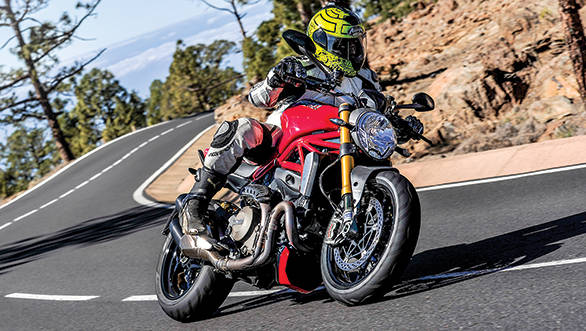 The Ducati Monster 1200S is a neat handler
The Ducati Monster 1200S is a neat handler
The new generation Monster is much larger now and everything is completely new, but even when I looked at the bike from a distance as I approached the hotel, it still looked very much like a Monster. The compact round headlamp and the bulbous tank being the striking feature here. The headlamp now features LED position lights on either sides while the tank is larger and made of steel, it can now hold 17.5-litres of fuel. When viewed from the side, the mass seems more focussed to the front of the motorcycle thanks to the large tank, snake shaped headers, trellis frame and the L-twin engine. But in fact, the weight distribution is now more towards the rear (52 per cent), the wheelbase has grown thanks to a longer swing arm, and since there is no conventional rear number plate holder, the rear end looks more stubby. The number plate holder is now a wheel-hugger with a single side arm similar to the Diavel. The rear indicator stalks neatly integrate with the grab rails, while the taillamp is an LED unit. If there is one angle that is different from the various Monsters we've seen so far, it definitely is the rear end.
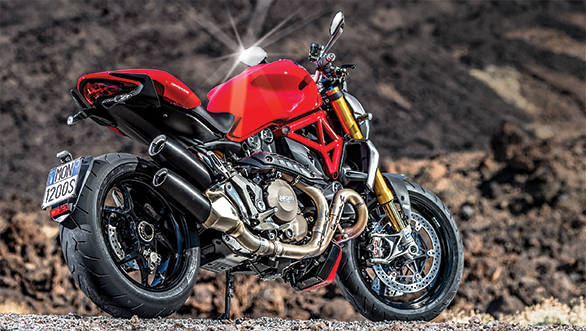 The tail gets the biggest redesign
The tail gets the biggest redesign
The big change however is the engine. The Monster for the first time features a radiator. That's because the motor is now liquid-cooled since it gets the superbike derived 1198 Testastretta 11 motor. The engine is similar to the one seen in the Multistrada but with many changes and tweaks. The engine's compression ratio is slightly higher while the Mikuni throttle bodies are smaller and situated in the airbox and is not oval like in the Multistrada, but circular. This helps produce more torque at low-mid rpm, while a 2-1-2 exhaust system is used to suit the Monster's street friendly character. For improved combustion, the motor also gets dual spark ignition. The oversquare engine puts out 145PS at 8750rpm (10PS more than the regular 1200 and a whopping 45PS more than the outgoing 1100 EVO) and 124.5Nm of torque at 7250rpm making it the most powerful Monster ever. The engine features a wet clutch with a standard slipper function for both the 1200 and 1200S.
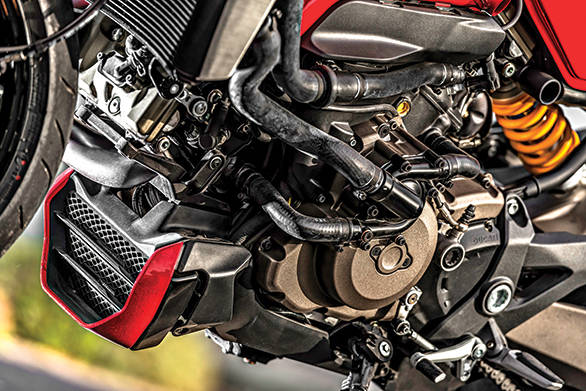 This is the first Monster with liquid cooling
This is the first Monster with liquid cooling
The Monster uses a ride-by-wire system and as a result offers three riding modes to choose from just like in the Diavel and the Multistrada Sport, Touring and Urban. These are essentially three different power maps. Sport mode offers 145PS of power (135PS in the Monster 1200) with a faster throttle response, reduced traction control intervention and level one ABS. Touring also offers the same power output but with a throttle response better suited for everyday riding, while the traction control intervention is on the higher side. Level two ABS is the default setting in this mode and rear lift-up prevention is activated. The Urban mode provides 100PS of power ( the maximum power of the older 1100 EVO!) with a more relaxed throttle response, increased traction control intervention and an ABS setting that offers maximum braking stability. All three modes can be customised if needed and saved to your preference, the three-way adjustable ABS and eight level traction control system can be completely switched off too. And because the Monster now gets a Panigale-style full TFT colour instrumentation, the various riding modes even get their own layout, offering relevant information but a gear indicator is missing.
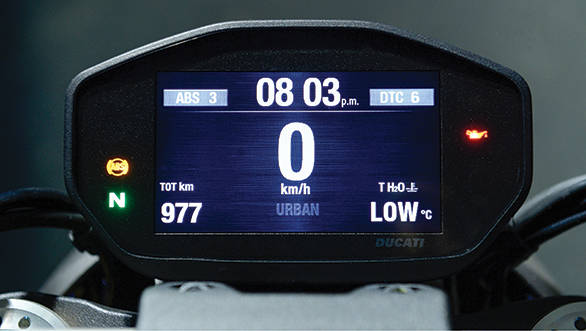 All digital TFT instrumentation
All digital TFT instrumentation
Riding round Tenerife's twisting roads and straight motorways, I found myself using the touring mode more often, power delivery is smoothest in this setting and with 145PS on tap, the bike effortlessly cruised at speeds over 160kmph. It's a torquey motorcycle and one can feel it the moment you start riding. There is sufficient power and at times I didn't feel the need to downshift gears, it just pulls away with such ease. Whack the throttle open and the bike lifts up and shakes you up a little. The engine revs all the way to 10,500rpm but then one hardly needs to shift late, you can do high speeds and still let the engine relax thanks to the ample amount of torque offered. The L-twin motor roars beyond 6,000rpm, while the exhaust note is perfectly pitched, not too loud and still very involving. Since we rode around the island, we had to pass through the city centre and crowded areas just like in India. This is where the Urban riding mode was put to use and it was a very comfortable feeling. Back on to open roads, I rode for a bit in Sport mode but found the throttle too sharp and aggressive. One needs to concentrate more and be very precise with input but if you love doing power-wheelies, sometimes even unintentionally, then this is the mode for you.
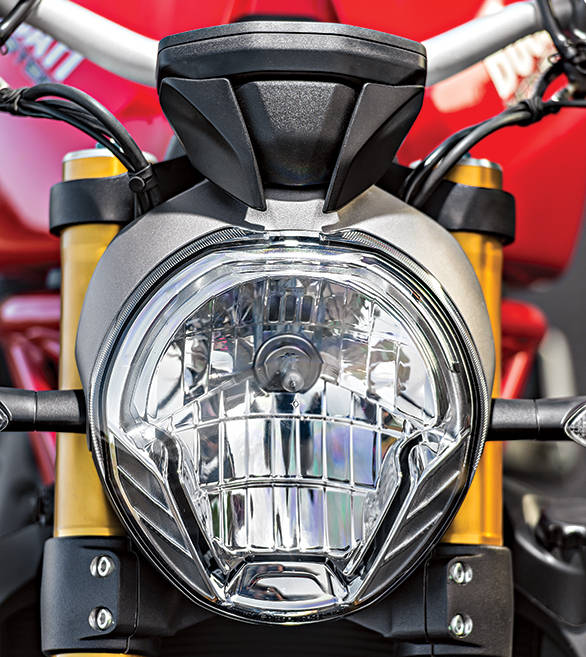 LED position lights in the headlamp
LED position lights in the headlamp
Ducati have made good use of already existing technologies and features seen in other models. The other important change to the new generation Monster is the chassis. All the Monsters in the past two decades have featured the signature trellis frame, and so does the latest Monster, but its attachment points have now moved to the engine's cylinder heads. The engine is the stressed member, the rear subframe and suspension are also mounted to the engine. This method has been pioneered on the tech-laden Panigale. The modern frame design along with larger steel tubing has doubled the torsional stiffness compared to the previous generation Monsters. The 1200S even gets fully adjustable Ohlins forks and rear monoshock. Riding through the mountains of Tenerife, we rode past volcanic rocks, this region is dry and there are no trees to hold air and since winds are strong, weather fluctuates a lot and expands and contracts the tarmac. This fluctuation has resulted in undulated and cracked roads, similar to what we see in India. I was riding at triple digit speeds on these roads but the ride was still surprisingly comfortable and high speed stability was impressive too, the extended wheelbase definitely helping. Around the million smooth twisties around the island that were dry and at times suddenly damp, the bike held its line really well and was involving. The weight distribution is more towards the rear, so the front feels light and agile.
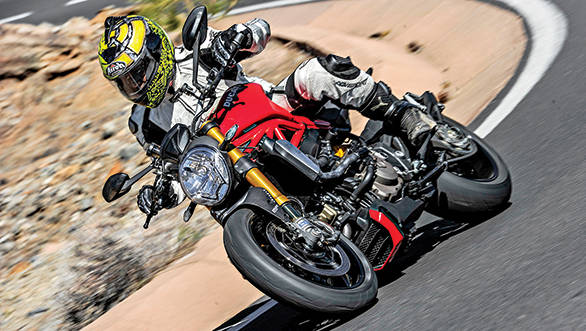 Powerful brakes lifted off the Panigale
Powerful brakes lifted off the Panigale
The Monster 1200 may be much larger, but it is still very easy to ride, even around sharp hairpin turns going downhill at slower speeds. In fact it feels like riding a much smaller naked motorcycle. A lighter front and Brembo front brakes (330mm discs and four piston calipers) lifted straight off the Panigale is claimed to make the new Monster 1200S the best braking Ducati ever built, it doesn't bite hard but feels progressive. However, I did feel the rear brake to be a bit spongy. The ergonomics are good too, the handlebar has moved 40mm higher and closer to the rider. This position felt ideal, slightly leaned forward and still comfortable to ride whole day. The seat is height adjustable, wider and packs in more padding too. After riding close to 200km around the island, I was hardly tired and ready to ride another 200km. It's a motorcycle you can ride every single day. It is quite efficient too, after we were done riding, I checked the on-board computer and it showed an overall fuel efficiency of 16.5kmpl. Impressive indeed.
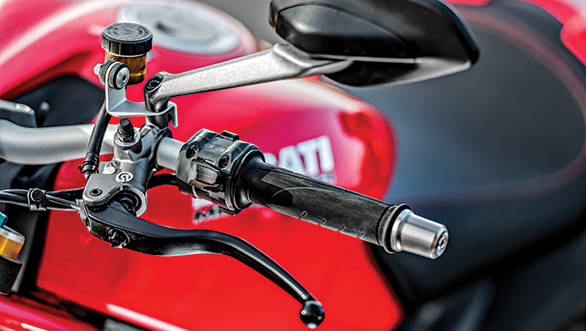
Ducati's flagship Monster is now feature friendly, more advanced, much more powerful, efficient and stronger than ever, but this comes at a price. The Monster 1200 is priced at Rs 11 lakh, while the more powerful 1200S that we rode costs close to Rs 13.5 lakh, these prices are excluding duties. So when it makes it to India, expect the motorcycle to be priced upwards of Rs 22 lakh. At this price, the motorcycle is definitely overpriced especially when compared to rivals like the Kawasaki Z1000 and Triumph Speed Triple. This is a problem, because in India, the Monster is perceived as an affordable Ducati. But then there is good news too, the Italian manufacturer says that they are confident of entering India officially by end of this year and even start assembling bikes in the future. A more affordable Monster 1200 then? Well, start waiting.
Starts Rs 10,99,000
937cc
6-Speed
112.00
93.00
-NA-
-NA-
1198cc
6-Speed
145.00
124.00
-NA-
Starts Rs 15,60,000
1043cc
6-Speed
142.00
111.00
20.40 Kmpl
Starts Rs 11,46,700
1050cc
6-Speed
127.00
105.00
-NA-
Related Stories
Top Stories
Latest Videos
Most Popular
- Budget Sportbike Showdown: Kawasaki Ninja 500 vs Aprilia RS 457 vs Yamaha YZF-R3
- 2014 Triumph Daytona 675 vs 2024 Kawasaki ZX6R - A Decade of Evolution in Supersport Motorcycles
- Mumbai-Pune Expressway speed restrictions updated
- Nissan Magnite EZ-Shift review - is the AMT any good?
- Nitin Gadkari states that tax on Hybrids should be reduced to 12 percent in the coming future
